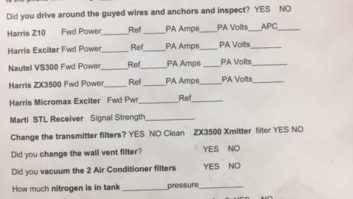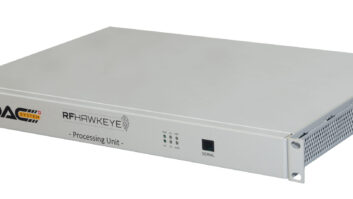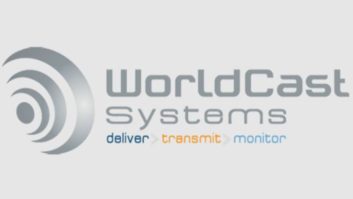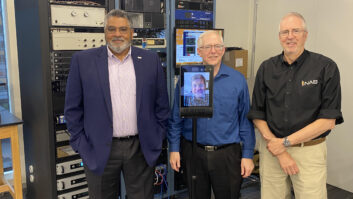Test and Measurement Needs for the Shop
Dec 1, 2012 9:00 AM, By Doug Irwin, CPBE DRB AMD
Test equipment needs of the typical broadcast engineer have changed substantially over the last 30 years. Back then your typical engineering shop would have a Simpson 260 and probably some sort of oscilloscope. A good shop would have some sort of audio analyzer (usually Hewlett Packard or Sound Technology). The best shops would have an RF spectrum analyzer as well.
Since all the audio was analog, you were simply able to use your ears (and a set of headphones) to troubleshoot a lot of studio problems. As time went on, and more and more digital audio systems came in to use, the ears simply weren’t as useful; having some type of AES generator/decoder became important. Now, though, that’s not even enough; with so much streaming media around the station, new tools have become necessary. If you were to build an engineering shop today, what test equipment is necessary, and what’s available?
Digital multi-meters
If you were stranded on a desert island with only one piece of test equipment, of course you would take a digital multi-meter (DMM). Unlike its ancestors (like the Simpson 260) these don’t just measure ac and dc voltage and resistance — optionally many other types of measurements are available.

Fluke 287
Perhaps I’m biased, but to me the gold standard of multi-meters has always been Fluke. The company has a page to match desired features with available models. As an example I picked the Fluke 287, which has true RMS measurements for ac and dc and 100kHz bandwidth making it useful for audio measurements. It has a frequency counter built-in (up to 1MHz) along with a capacitance meter. When you’re trying to get the most bang for the buck, clearly feature such as this make this device more attractive.

Agilent U1252B
One of the oldest (if not the oldest) test equipment companies has to be Agilent — not in name of course — since it’s ancestor is the venerable Hewlett-Packard. (After all, those partners started making test equipment in a garage in the 1930s.) Agilent also makes a series of handheld DMMs. The company has a product guide as well.
As an example I’ve chosen the U1252B. Like the Fluke 287, it has ac and dc true RMS voltage measurements, and 100kHz bandwidth. Voltage scale is 50mV to 1kV; current range is from 500�A to 10A. Perhaps its most interesting feature is its ability to log data internally or to a PC. For long, continuous measurements, you would use the DMM with an available GUI and data-logging software to automate data recordings to a PC.
– continued on page 2
Test and Measurement Needs for the Shop
Dec 1, 2012 9:00 AM, By Doug Irwin, CPBE DRB AMD

Rolls CS1000
For the toolbox
Another item that allows you to work smarter is a cable tester. Rolls makes CS1000. It can test 10 different connector types: banana, 4-pt Speakon, 1/4″ TRS, 1/8″ TRS, XLR male and female, MIDI (up to 7 points), RJ-11 and RJ-45. Aside from its continuity tester it includes a 1kHz tone generator, which is useful for checking inputs to amps, etc. A 9V battery is used for power.

Hosa CBT-500
Hosa makes the CBT-500, which can diagnose signal failure in cables terminated with any combination of XLR, phone, phono and Speakon connectors, as well as DIN, Ethernet and USB Type A to Type B cables. It is also equipped with removable leads to verify continuity of additional connectors and jacks. It operates on a 9V battery.
Although I don’t believe that they are quite as necessary as they used to be around the shop, having a good oscilloscope is still important for troubleshooting, especially at component level. A scope can give you a lot of insight in to what is happening in real time in a circuit — much more so than a DMM. Also, with a typical two-input scope you can check left channel vs. right channel phase using the lissajous configuration — make sure the scope has X vs. Y on its horizontal mode selector. You can check input vs. output of any circuit under test, which is still useful in the analog realm.

Tektronix TDS 1001B
To me, Tektronix has always been synonymous with the best in oscilloscopes. Features that were practically unheard of 20 years ago are commonplace now — like digital storage. The TDS-1000B series is available in bandwidths up to 100MHz, with sample rates up to 1 gigasamples per second; two channels (of course) and a monochromatic LCD display. It has PC Connectivity through the USB Device Port, with OpenChoice and NI SignalExpress PC Software. You can print to all PictBridge compatible printers by way of the USB port. Perhaps the best thing about it is the portability aspect: It only weighs about 4.5lbs.
– continued on page 3
Test and Measurement Needs for the Shop
Dec 1, 2012 9:00 AM, By Doug Irwin, CPBE DRB AMD
New ears

Ward-Beck ABB-1
I wrote earlier that you used to be able to use your ears to troubleshoot many problems around the radio station. In today’s environment you need an electronic interface of some sort (instead of headphones). For tracking down digital problems a very common pair of items is the Ward-Beck ABS-1 (Audio Bit Spitter) and the ABB-1 (Audio Bit Buddy). With the ABB-1, digital and analog program audio can be monitored by the headphone output while the L/R levels are displayed on LED bargraph meters. Critical signal parameters such as sampling frequency, emphasis, professional/consumer format and data errors are displayed when monitoring AES/EBU or S/PDIF signals. Digital input monitors sampling frequencies from 30kHz to 50kHz automatically.
The ABS-1 is the AES generator. It’s battery powered, and it generates an AES3 digital data stream (with sample rates of 32, 44.1 or 48kHz) with audio levels (encoded in the data stream) of -20, -12, and 0dBFS. It also generates analog outputs at levels of -16, -8 and +4dBu (on 1/4″ TRS connectors). To distinguish between the CH A and CH B (left and right) signals, the unit provides the option to cycle and/or invert the CH B (right) signal or to turn it off completely.

NTI DL1
Another option for a hand-held digital audio analyzer is the NTI DL1. The DL1 measures multiple aspects of the AES data stream, such as carrier level and sample rate, and channel status for professional or consumer mode. It continually checks the integrity of the incoming data stream and will alert the user to inconsistencies, and since it has built-in logging it can more easily help the user figure out intermittent issues. Decoded audio is available on a small speaker and headphone output. Included also is a small time-domain display (kind of like a mini-oscilloscope) that displays the decoded audio. Beside peak level measurements, the DL1 is equipped with RMS measurement techniques including THD+N and high pass filters, allowing verification and debugging of dual domain devices such as A/D converters.

NTI DR2
The complementary signal generator for the DL1 is the DR2. This device has a transformer-balanced output for AES3, and also S/PDIF, TOS-link and ADAT outputs. The internal low jitter clock generator can be synchronized to AES3, DARS, word clock and video signals. Measurement of channel transparency, channel propagation delay and sample frequency is supported. The DR2 has the digital audio test signals used for maintenance and repair of digital audio systems, but the user can store his own test signals as WAV files in the DR2’s memory.
– continued on page 4
Test and Measurement Needs for the Shop
Dec 1, 2012 9:00 AM, By Doug Irwin, CPBE DRB AMD

Prism Sound dScope Series III
Perhaps you need a little more capability though; a more sophisticated analyzer is called for. In that case you could look at Prism Sound‘s dScope Series III audio analyzers. These are audio test and measurement systems comprising a Windows PC software application coupled with an external audio interface processor for equipment-under-test (EUT) connections. The external interface processor connects to the PC via a standard USB connection making it easy to use with a wide range of PCs, including laptops, and it includes analog and digital outputs and inputs for measurement applications. Additionally, the software also allows the dScope to use installed Windows sound devices such as sound cards generator outputs or analyzer sources. As you would expect, there is a wide choice of standard functions including sine, square, ramp and noise plus complex waveforms (e.g. bursts, pulses, swept sine and twin-/multi-tones). You can also create waveforms via scripting, and you can playback standard WAV files from the outputs of the signal generator, allowing for the most subjective of tests. The dScope Series III provides a continuous-time analyzer (CTA) for continuous display of standard measurements, in addition to fast Fourier transform analyzer (FFTA) for detailed spectral analysis or complex measurements.
The digital age

LP Technologies LPT-3000
If you maintain transmitters (of any type) than having an RF spectrum analyzer is practically a necessity. Having HD Radio transmissions makes that even more important. Let’s take a look at a couple of options. First, the LPT-3000 from LP Technologies: this analyzer covers the frequency range of 9kHz up to 3GHz, with a 100dB display range on a 6.4″ color TFT LCD display. To facilitate testing, you can add the correct ‘mask’ for measuring IBOC compliance to the display. The unit comes with both USB and LAN (optional) interfaces, and thus can be operated remotely. It has a large internal memory space, and allows you to save screen shots, and to print them out later. Other options include GPIB, a tracking generator, a return-loss bridge, and 300Hz RBW capability.

Agilent N9340B
Agilent has made spectrum analyzers for decades (up until fairly recently under the HP moniker). Its N9340B handheld spectrum analyzer has some great standard features. Its range is 100kHz to 3GHz, with results shown on a 6.5″ TFT color LCD, which (according to Agilent) is bright enough to use outdoors. Its internal battery has four hours of run time. It has one-button measurements for channel power and occupied bandwidth; it even has an AM and FM demodulator audio output. I make mention of this particular unit though because of its IBC option, designed to allow the user to make IBOC proof measurements. The N9430B-IBC (as it is known with the option installed) has a dedicated hard-key called MODE which allows the user to rapidly access to its operating modes (depending upon all the options purchased) such as spectrum analyzer, tracking generator, demodulation analysis, and of course IBOC measurements. Also, when entering IBOC measurement mode, you are given the choice between AM and FM, and the instrument automatically activates the appropriate internal hardware and software. It has a feature called Auto Tune embedded in the IBOC measurement mode that automatically sets the reference level and center frequency for you. It also comes pre-loaded with limit masks — 73.44 for analog AM; 73.317 for analog FM, AM NRSC-5B and FM NRSC-5B.
– continued on page 5
Test and Measurement Needs for the Shop
Dec 1, 2012 9:00 AM, By Doug Irwin, CPBE DRB AMD
To the network

Fluke NetTool Series II
Within the context of an article about test equipment for broadcast engineers network analyzer has more than one meaning of course. Even if you can’t justify the RF spectrum analyzer for your shop, you may still be able to get a network analyzer for your LAN. As one example, keeping budget in mind, let’s look at the Fluke NetTool Series II inline network tester. This device simply plugs in between a network node (say a switch port) and the host. You then use it to perform testing on that link. For example, you can sniff MAC and IP addresses, subnet and services offered by active servers, routers and printers. You can identify spyware, malware, and viruses, or other unexpected traffic with port monitoring. Analyze frames on the LAN. You can troubleshoot authentication issues with 802.1x log. If you are making use of VoIP phones, insert it inline to test boot-up and call-control issues, or to simply make PoE measurements. And yes — you can use it to do cable testing as well.
Test equipment needs of the typical broadcast engineer have changed over the years, but many remain the same. Analyze your specific needs, know your budget, and make purchases that will allow you to work as efficiently as possible.
Irwin is transmission systems supervisor for Clear Channel NYC and chief engineer of WKTU, New York. Contact him at [email protected].
December 2012
WYSO rebuilds while facing challenges, test and measurement gadgets for your workshop, on-air condenser mics, social media software and Field Reports from Tascam and NewTek….











